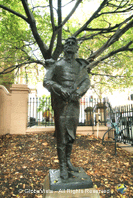
There is one thing we must all admire in the character of Lachlan Macquarie, who ruled over the destiny of Australia between the years 1810 and 1821. He was a man of large ideas, who looked beyond the present into the future. So when Macquarie conceived the idea that Sydney required a Cathedral Church, he called to him his trusty architect, Greenway, and these were his instructions.
The Cathedral was to be 200 feet square, 100 feet high, with a tower 150 feet; it was to be of stone from a quarry at the Market Wharf. The church was to stand in the centre of a noble square, extending on the south half-way to Liverpool street, on the west to Kent street, on the north to Druitt street, and on the east as far as Pitt Street. The main roads were either to intersect or communicate with this square.
On September 1st, 1819, Macquarie, with the ceremony he seriously regarded as part of his official duty, laid the first stone of St. Andrew’s Cathedral.
A few weeks after the laying of the foundation stone, Mr. Commissioner Bigge arrived in the colony to inquire into Macquarie’s stewardship, and amongst his first acts was the vetoing of a number of buildings then in course of erection, including that of the Cathedral and it was not until May 16th, 1837, that the building was proceeded with. By this time it was impossible to carry out Macquarie’s grand project, and the original foundation stone was lifted from its place in what was then George street and relaid where it now stands by his Excellency Governor Bourke.
